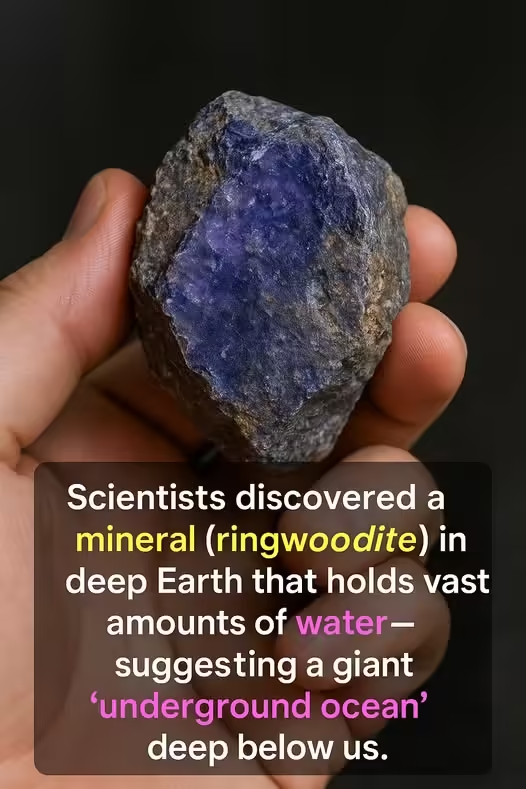In 2014, a tiny diamond stunned the scientific world—not for its brilliance or value, but for the secrets it held deep inside. Embedded within the crystal was a rare mineral called ringwoodite, formed under immense pressure hundreds of kilometers beneath Earth’s surface. What made this discovery so extraordinary was that the ringwoodite contained water—not as a liquid, but trapped at the molecular level in its crystal structure.
This groundbreaking finding offered the first direct evidence that vast reservoirs of water exist deep in Earth’s mantle—a revelation that has the potential to redefine our understanding of Earth’s geology, hydrology, and climate stability.
The Deep Water Mystery
Ringwoodite forms in a layer of the mantle known as the transition zone, located about 410 to 660 kilometers below the Earth’s surface. Conditions in this zone—extreme heat and pressure—allow certain minerals to trap water molecules within their structure. Scientists had long suspected that water might exist in this form deep underground, but until 2014, there was no physical proof.
The diamond containing ringwoodite, extracted from a Brazilian volcanic region, changed everything. Using spectroscopy and other analytical techniques, researchers confirmed the presence of water molecules within the mineral. The conclusion? The Earth’s mantle could be holding a massive, sponge-like reservoir—perhaps three times the volume of all the oceans on the surface combined.
More Than Just a Curiosity: Why It Matters
At first glance, this might seem like an intriguing scientific footnote. But in reality, it touches the heart of many fundamental processes that shape our planet.
🌍 Regulating Tectonic Movements
Water reduces the melting point of rocks and acts as a lubricant within Earth’s crust and upper mantle. The presence of deep water influences how tectonic plates move, how earthquakes initiate, and how magma forms and rises. Without water in the mantle, Earth’s tectonic activity might be dramatically different—or even nonexistent.
🌋 Fueling Volcanic Activity
Water in the mantle contributes to volcanic eruptions by generating magma. This process cycles water and other volatile elements back to the surface, shaping landscapes and replenishing Earth’s atmosphere with essential gases over geological time.
🌡️ A Deep Link to Climate Stability
Believe it or not, this underground water reservoir may even help regulate Earth’s climate. By playing a role in the carbon cycle, through subduction and volcanic outgassing, the deep Earth helps buffer climate swings over millions of years. This makes it an unsung hero in the story of Earth’s long-term habitability.
Rethinking the Water Cycle
Most of us think of the water cycle as something we can see: oceans, rivers, clouds, rain. But the discovery of deep-mantle water introduces a new, hidden dimension. Beneath our feet, water is constantly being cycled through subducting tectonic plates and released via volcanic activity. This expanded understanding shows us that Earth’s water is not confined to the surface—it’s an interconnected system that extends deep into the planet’s interior.
A Planet Full of Surprises
The idea that our planet holds a hidden ocean locked within minerals—one that rivals or even surpasses the volume of surface oceans—is truly mind-bending. It reminds us that for all we’ve discovered, Earth remains a planet of deep mystery.
From a single, unassuming diamond came a discovery that rewrites textbooks, challenges old assumptions, and invites us to look deeper—both literally and figuratively—at the world we live in.
So the next time you stand on solid ground, remember: beneath you lies an invisible sea, quietly helping keep the planet alive.



